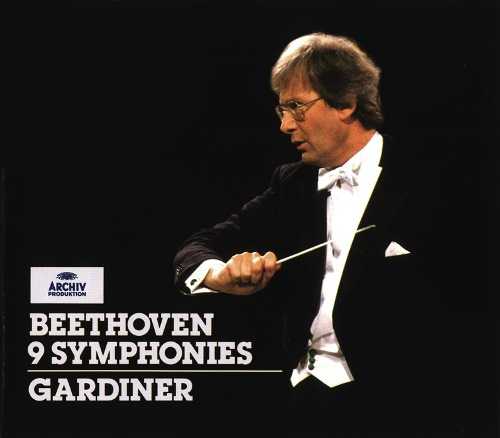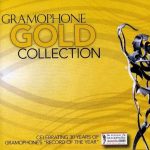
Performer: Luba Orgonasova, Anne Sofie von Otter, Anthony Rolfe Johnson, Gilles Cachemaille, The Monteverdi Choir
Orchestra: Orchestre Revolutionnaire et Romantique
Conductor: John Eliot Gardiner
Composer: Ludwig van Beethoven
Audio CD
SPARS Code: DDD
Number of Discs: 6 CD box set (CD 01-05 Available)
Format: APE (image+cue)
Label: Archiv Produktion
Size: 1.34 GB
Recovery: +3%
Scan: yes
# Symphony No. 1 in C major, Op. 21
Composed by Ludwig van Beethoven
Performed by Orchestre Revolutionnaire et Romantique
Conducted by John Eliot Gardiner
# Symphony No. 2 in D major, Op. 36
Composed by Ludwig van Beethoven
Performed by Orchestre Revolutionnaire et Romantique
Conducted by John Eliot Gardiner
# Symphony No. 3 in E flat major (“Eroica”), Op. 55
Composed by Ludwig van Beethoven
Performed by Orchestre Revolutionnaire et Romantique
Conducted by John Eliot Gardiner
# Symphony No. 4 in B flat major, Op. 60
Composed by Ludwig van Beethoven
Performed by Orchestre Revolutionnaire et Romantique
Conducted by John Eliot Gardiner
# Symphony No. 5 in C minor (“Fate”), Op. 67
Composed by Ludwig van Beethoven
Performed by Orchestre Revolutionnaire et Romantique
Conducted by John Eliot Gardiner
# Symphony No. 6 in F major (“Pastoral”), Op. 68
Composed by Ludwig van Beethoven
Performed by Orchestre Revolutionnaire et Romantique
Conducted by John Eliot Gardiner
# Symphony No. 7 in A major, Op. 92
Composed by Ludwig van Beethoven
Performed by Orchestre Revolutionnaire et Romantique
Conducted by John Eliot Gardiner
# Symphony No. 8 in F major, Op. 93
Composed by Ludwig van Beethoven
Performed by Orchestre Revolutionnaire et Romantique
Conducted by John Eliot Gardiner
# Symphony No. 9 in D minor (“Choral”), Op. 125
Composed by Ludwig van Beethoven
Performed by Orchestre Revolutionnaire et Romantique
with Gilles Cachemaille, Anne Sofie von Otter, Luba Orgonasova, Anthony Rolfe Johnson
Conducted by John Eliot Gardiner
# Interview with John Eliot Gardener
Composed by John Eliot Gardiner
# Interview with John Eliot Gardener
Composed by John Eliot Gardiner
# Interview with John Eliot Gardener
Composed by John Eliot Gardiner
Disc: 1
1. 1. Adagio molto – Allegro con brio
2. 2. Andante cantabile con moto
3. 3. Menuetto: Allegro molto e vivace
4. 4. Adagio – Allegro molto e vivace
5. 1. Adagio molto – Allegro con brio
6. 2. Larghetto
7. 3. Scherzo: Allegro
8. 4. Allegro molto
Disc: 2
1. 1. Allegro con brio
2. 2. Marcia funebre: Adagio assai
3. 3. Scherzo: Allegro vivace
4. 4. Finale: Allegro molto
5. 1. Adagio – Allegro vivace
6. 2. Adagio
7. 3. Allegro vivace
8. 4. Allegro ma non troppo
Disc: 3
1. 1. Allegro con brio
2. 2. Andante con moto
3. 3. Allegro
4. 4. Allegro
5. 1. Erwachen heiterer Empfindungen bei der Ankunft auf dem Lande – Allegro ma non troppo
6. 2. Szene am Bach – Andante molto mosso
7. 3. Lustiges Zusammensein der Landleute – Allegro
8. 4. Gewitter, Sturm – Allegro
9. 5. Hirtengesang: Frohe und dankbare Gefühle nach dem Sturm
Disc: 4
1. 1. Poco sostenuto – Vivace
2. 2. Allegretto
3. 3. Presto
4. 4. Allegro con brio
5. 1. Allegro vivace e con brio
6. 2. Allegretto scherzando
7. 3. Tempo di Menuetto
8. 4. Allegro vivace
Disc: 5
1. 1. Allegro ma non troppo, un poco maestoso
2. 2. Molto vivace
3. 3. Adagio molto e cantabile
4. 4. Presto –
5. 5. Presto -“O Freunde, nicht diese Töne!” – Allegro assai
Disc: 6 Interview with John Eliot Gardener not included
1. In English
2. Auf Deutsch
3. In Français
gardiner_beethoven_9symphonies02.rar – 318.1 MB
gardiner_beethoven_9symphonies03.rar – 315.0 MB
gardiner_beethoven_9symphonies04.rar – 275.9 MB
gardiner_beethoven_9symphonies05.rar – 254.8 MB
Superb period performances with splendid sound!
These performances of the Beethoven symphonies with John Elliot Gardiner leading his Orchestre Revolutionnaire et Romantique were originally produced by DG in 1994. We have here the Archive Production reissue, and it is superb. The ORR is a 79-member period instrument orchestra of the so-called Historically Informed Performance tradition. But don’t let that designation scare you away. You won’t hear any screechy violins that might diminish your enjoyment but their often this sound. Rather, you are in for a real treat. These are highly (but not overly) charged accounts of the symphonies that are splendidly recorded, and in no way sound 20 years old. If you, like me, believe that recessed timpani can degrade otherwise wonderful recordings, you will love these accounts, for period drums frankly kick ass. I have been ambivalent when it comes to Gardiner’s choral work, because too often “charged” becomes “punchy.” Not so, here. There is just plenty of good, old-fashioned energy. No, make that ENERGY!
Period instruments provide that “fresh” feel to Symphonies 1 & 2. LVB was always at the edge in his symphonies, but the lush sound of modern strings dampen one’s ability to imagine being in the original venue and being struck by this brash, new symphony composer. The Minuetto of Symphony 1 is just glorious. The profound opening to the 2nd Symphony has plenty of weight, but Gardiner doesn’t belabor its gravity, and there is wonderful flow to the movement. Unlike many period performances, Gardiner’s tempos don’t seem particularly hurried to my ears.
The Eroica is early mature Beethoven from start to finish, but Gardiner gives the listener more to appreciate in way of more pronounced dynamics and a slightly faster flow with more lightness in the softer passages. The Scherzo is appropriately intense, and climactic passages are everything you could hope for from period instruments, that is unless you are an enthusiast of overbearing gravitas. Likewise, the Finale is full of intensity and, when appropriate, majesty. Gardiner allows me to hear the parts better without sacrificing the sense of intensity. I certainly enjoyed his approach and will return to this Eroica often. In Gardiner’s hands, Symphony 4 sounds like a more mature work than its predecessor, and it most clearly demonstrates Gardiner’s ability to peel away the cobwebs of tradition while preserving the music’s dignity. I think his account has quickly become my favorite performance of the 4th. You have to hear it!
Gardiner’s account of the 5th Symphony is excellent. It has elements of Kleiber’s electricity along with some very sweet passage work at times (remember, Beethoven was not completely hell-bent on scaring the bejesus out of us in this work). The brass are especially impressive. The 2nd Movement has just the right ebb and flow. Tempos seem spot-on to me across the board. There is grandeur everywhere. The final coda in the 2nd Movement is simply beautiful, but the grand rush to the concluding bars lacks a bit of weight. It is during this symphony that I really missed the power and forces that the modern orchestra can give interpreters such as Carlos Kleiber. When the 3rd Movement yields to the 4th, there is electric intensity under Gardiner’s baton. This is one of my (and probably everyone else’s, as well) favorite symphonic movements, and the orchestra does not disappoint. Not as white-hot as Kleiber, I’ll grant you, but it is a piece of very fine orchestral work. Brass and timpani are both thrilling and don’t be surprised if it evokes some teary eyes. (I must confess, however, that mine will moisten with lesser accounts.) The final accelerando again made me wish for greater forces.
An LP of Symphony 6 was my first Beethoven symphony as pubescent kid. I still love it! Gardiner’s interpretation is Pastoral without ever sacrificing intensity. The 2nd Movement, however, was clearly played by period strings which seemed thinner than I would have expected after listening to the previous five symphonies. The horns of the 3rd Movement are glorious, and the lower strings are equally impressive. The real test of period orchestral forces is, of course, the storm scene of the 4th Movement. The ORR passed with conditional honors, a very honorable effort, to be sure. After the storm clouds subside, we are back to some very fine music making with only a trace of lightness in terms of weight. When the theme appears in the prominent horns (or should) in the 5th Movement, I had to strain to hear them. What a curious engineering snafu.
Symphony 7 with Gardiner and the ORR is a veil-lifting experience. Although I love what a modern orchestra can do with this symphony, I experienced the sensation that was hearing more of what was in Beethoven’s creative mind at the moment of composition when listening to the current forces. The Allegretto moves along with melancholic intensity at an unhurried pace. It was simply beautiful, and the period instrument climaxes were excellent. Symphony 8 comes through with surprising success.
Symphony 9 is more of a mixed bag. From the onset, the thin period violins once again made me wish for instrumental modernity. Violin issues aside, this performance demonstrates the same intensity, slightly faster but unhurried tempos of its predecessors. The 2nd Movement (the old theme for NBC’s Huntley and Brinkley Report before John Williams got in there, for those of you old enough to remember the news show) is beautifully played but there was frequently a wish for modern instruments and their added richness and weight, especially in tutti passages. The same issue is seen in Symphonies 3-8. Movement 3 offers a needed respite from the agitation of the 2nd Movement, and it should be highlighted in Gardiner’s resume. It is that lovely. The final movement is hugely successful. The soloists are uniformly stellar, but the relatively small size of the chorus is a negative factor.
I must apologize for the length of this review, but there was just so much that needed comment. Needless to say, I very much enjoyed Gardiner’s cycle. The recorded sound is pristine and somewhat close. For who enjoy period performances, this period Beethoven cycle is second to none. For me, I prefer the modern orchestra for its richness and weight, but these performances are very impressive. I found Symphonies 4 and 8 to be the best of the cycle. They seem to defy the limitations of period instruments better than the others. Honorable mention goes to the 3rd, 5th and 7th. In each of the symphonies, however, Gardiner opens the drapes and gives superbly interpreted performances. I will return to 3, 4, 5, 7, and 8 often. Very Highly Recommended.




Great set. Thanks
Thank you very much
Thank you so much! I have been looking for this for a long time, greatly appreciated!